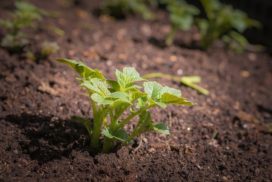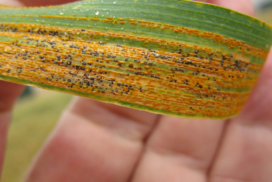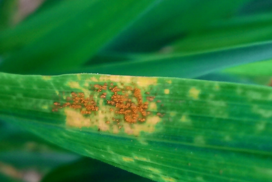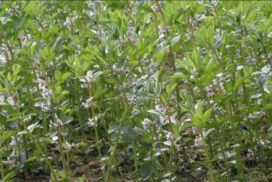Crop Health Updates - May 2020
Rain has been very welcome in greening up crops and relieving some of the stresses. The downside is that it increases disease risk but at least we are starting from a low disease pressure situation, and at the moment disease pressure is lower than in many a season. Yellow rust is still a bit of an issue but is now pretty well controlled as we are now within the safety of standard fungicides programs. The 20th May is the last day where the use of storage of chlorothalonil products was legal so we are now adjusting programs to a post-chlorothalonil situation.
Pest activity is increasing now that we are moving into warmer sunny weather (at the time of writing at least). All crops should be checked for aphids and evidence of other pests. ‘Invisible’ pests such as cabbage root fly and carrot fly grubs and leatherjackets will be feeding below ground so it is worth digging up a few plants to see if grubs can be seen. There are reports of rape winter stem weevil damage in some oilseed crops, something worth keeping alert for and reporting to your agronomist should you see any evidence.
Ragwort - May 2020
Ragwort is a biennial and a fresh batch of rosettes germinate each spring, particularly if there are gaps in the sward, and plants have been allowed to seed in previous years. Preventing seeding, and maintaining a good thick sward helps prevent germination of new rosettes and is a good long-term strategy in order to reduce the seed bank in the soil, although as ragwort seeds are wind-borne, seeds can be blown in from neighbouring areas. Read more here.
Potatoes: Potato Blight Update late May 2020
In 2019, the first year 36_A2 was detected in Scotland, this genotype was quite widespread. It is very likely that it will be prevalent in 2020. To date, there is some direct evidence, and quite a lot of circumstantial evidence, that this genotype is more difficult to control than others, e.g. 13_A2. To protect crops during periods of high-risk weather, especially where risk continues for 3 or more days, it is advised that a shorter spray interval, e.g. one of 5 or 6 days, is used at these times. Read more here.
Spring Oats - May 2020
Monitor and compare your crop growth with the latest commercial crop data from SRUC's adopt a crop monitoring records. Keep an eye for patches of stunted growth - these may indicate cereal cyst nematode. Read more here.
Spring Barley: Plant growth regulators - May 2020
With the dry conditions and some patchy germination, the last thing many spring barley crops need is a growth regulator. Crops under stress should not be treated with a growth regulator. Much of the spring barley grown is for low N malt and as these malting crops are grown in less fertile situations with reduced N fertiliser, they are generally at low lodging risk and do not require a growth regulator. Read more here.
Winter Barley: Disease risk - Late May 2020
Disease levels are still low and yellow rust has usually been well managed by T1 sprays. Its presence though, and the recent rain and swing back to warmer temperatures send a strong message about the need to keep spray intervals tight and not allow yellow rust an easy window to sneak back in. The removal of chlorothalonil changes flag leaf spray plans significantly. All other options are more expensive and as a multisite, it helped to steward against fungicide resistance. Read more here.
Saddle gall midge
Saddle gall midge is potentially a serious pest of continuous cereals such as wheat, barley and rye (but not oats), and has been seen in Scottish crops occasionally over the last few seasons. Adult saddle gall midge should appear any day now and lay red eggs on the leaf surface in a line or grid following the leaf veins. Read more here.
Cereal leaf beetle
Cereal leaf beetle damage will soon be apparent in some areas if not seen already. The grub stage eats strips out of leaves. The grubs are slimy and resemble small slugs and will leave a nice stain on your trousers as you walk through the crop! Read more here.
Winter Barley: Disease risk - May 2020
Planning for booting sprays in barley will need to factor in that not all crops will have reached GS45-55 by the 20th May cut off for chlorothalonil use. The most responsive timing in the winter barley crop is the earlier T1 timing so the T2 spray aims to retain green leaf, manage any remaining foliar diseases, and keep ramularia levels down. Read more here.
Winter wheat: Diseases - May 2020
For most crops, the T1 is now applied. The dry conditions have reduced the disease risk although reports of yellow rust are relatively common, particularly around the coastal regions. Azole fungicides are really the backbone of keeping rust out and the efficacy of sprays where applied has been good. There are reports of rust on varieties with reasonable resistance ratings like Skyscraper which reflects the uncertainty about new rust races. Read more here.
Spring Barley: Disease risk - May 2020
The very dry conditions are not suiting spring barley germination and there are some slow to emerge and uneven fields. The very small upside is that the disease risk is reduced in dry weather, so there is some potential to save in T1 sprays and save the bulk of the fungicide spend to the T2 timing. This obviously needs careful consideration of the overall risk – so a site with lots of rhynchosporium every year or a weak variety might not be suited. Read more here.
Spring Barley: Pests - May 2020
Look for aphids on emerging shoots as they could be walking onto the crop from volunteers and grasses and some aphids have already been flying around this spring. An aphicide should be considered if aphid colonies are found as they could be carrying barley yellow dwarf virus (BYDV) and potentially spreading it into the crop. Read more here.
Spring Barley: Weed control - May 2020
Annual meadow-grass is not particularly competitive in spring barley, but it can be a serious nuisance at harvest, particularly in a wet harvest. Also, it can produce as many as 2000 seeds per plant, and dormancy is quite low so many of the seeds germinate in following crops. Annual meadow-grass significantly reduces the yield of grass swards, so if the field is likely to be in the grass in the next few years, it is worthwhile controlling in spring barley to limit seed return to the soil. Read more here.
Winter Barley: Disease risk monitoring - May 2020
Monitor Winter Barley growth rates to ensure disease control is timely. Planning for booting sprays in barley will need to factor in that not all crops will have reached GS45-55 by the 20th May cut off for chlorothalonil use. The most responsive timing in the winter barley crop is the earlier T1 timing so the T2 spray aims to retain green leaf, manage any remaining foliar diseases, and keep ramularia levels down. Read more here.
Winter Oilseed Rape: Disease risk - May 2020
Sclerotinia risk is low as spores have yet to be detected, plus humidity and temperature criteria risks are still low – they have only exceeded the 21 hour threshold in Orkney, Shetland and Wick so far this season, and only briefly even there. Read more here.
Winter Oilseed Rape: Pests - May 2020
With most crops now at early flowering the risk from pollen beetle is over, as they can access the pollen they crave. The pest to be concerned about now is cabbage seed weevil, and numbers need to exceed 1 weevil every 2 plants throughout the crop (not just in the endriggs) during flowering to justify an insecticide treatment. Read more here.
Virus seed management in seed potatoes - May 2020
Potential virus-vector aphids are already flying into crops in England, and the warm sunny weather in Scotland will likely lead to flights into Scottish crops imminently. We have a summary of the guidelines issued by the Scottish Aphid-Borne Virus Working Group here.
Closing the Gap in Spring Beans - May 2020
Grain legume yields are more variable than those of cereals – particularly winter cereals – and this is a major factor influencing decisions to grow beans despite their attractiveness in adding a protein crop to the farm and the other advantages in diversifying rotations and improving soil health. We've details of an online survey which you can be part of. Read more here.
Spring Peas & Beans: Pest management - May 2020
Spring sown crops should be checked for pea and bean weevil damage. The damage is very distinctive – notches eaten out of the sides of leaves. If the growing points of plants are being attacked then a pyrethroid insecticide treatment may be worthwhile. Read more here.
Pest management in vegetables and forage brassicas - May 2020
Egg-laying by cabbage root fly is now underway and will be exacerbated by the warm sunny weather, so any uncovered crops will be at risk. With the removal of chlorpyrifos (with the exception of gantry sprays on brassica plants), options available for cabbage root fly control are limited to cyantraniliprole as a module drench to broccoli/calabrese, brussels sprout, cabbage, cauliflower and also as a treatment to crops in the field such as brussels sprout, cabbage, cauliflower, broccoli, turnip and swede. Read more here.
Pests in Soft Fruits - May 2020
Pests are beginning to appear on strawberries. Aphids have already been seen on strawberries outdoors and in polytunnels. Crops should be checked for pests and any treatments applied before flowering. Slugs could also be a potential problem this season. Read more here.
Sign up to the FAS newsletter
Receive updates on news, events and publications from Scotland’s Farm Advisory Service




















